
Dar El Haddad is one of the oldest palaces in the medina of Tunis.

Dar El Haddad is one of the oldest palaces in the medina of Tunis.
This residence is located in the Artillery dead-end, in the historical area of the Khurasanid dynasty, near Bab Menara. [1] [2]

The palace was built in the 16th century by Saïd El Haddad, a wealthy chechia maker and a member of an Andalusian family settled in Tunisia. [3] [4] It is now owned by the municipality of Tunis. The National Heritage Institute restored it in 1999. [2] It was classified as an historical monument during the same year.
The architecture of Dar El Haddad is quite particular compared to the other palaces of the medina. Its entrance leads to a private way reserved to the owner of the residence and his family. Three vestibules lead to the courtyard which is surrounded by porticoes in three sides.

Tunis is the capital and largest city of Tunisia. The greater metropolitan area of Tunis, often referred to as "Grand Tunis", has about 2,700,000 inhabitants. As of 2020, it is the third-largest city in the Maghreb region and the eleventh-largest in the Arab world.

Mohammed Bey or M'hamed Bey was the eleventh Husainid Bey of Tunis, ruling from 1855 until his death. He was the son of Al-Husayn II ibn Mahmud and his second wife Lalla Fatima al-Munastiri.

The Medina of Tunis is the medina quarter of Tunis, the capital of Tunisia. It has been a UNESCO World Heritage Site since 1979.
Dar Djellouli is an old palace of the medina of Tunis. It is located in the Street of the Rich in Bab Jedid, near Tourbet el Bey.

Dar Bayram is an old palace located in the Andalusians Street, in the medina of Tunis. It is indexed as one of the biggest historical residences of Tunis, in the inventory of Jacques Revault, member of the Middle East and Mediterranean Studies Research Group.

Dar Ben Ayed is an old palace of the medina of Tunis. It is located in the Ben Ayed Street in Bab Jedid, near Tourbet el Bey and Souk Es Sabbaghine.
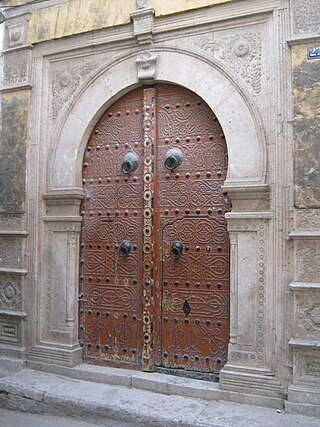
Dar Balma is an old palace in the medina of Tunis.

Dar Al Jaziri is a palace in the medina of Tunis. Located in the Tribunal Street, a few meters from Dar Lasram, it was one of the residences of the Jaziri family between the 12th and 18th centuries.
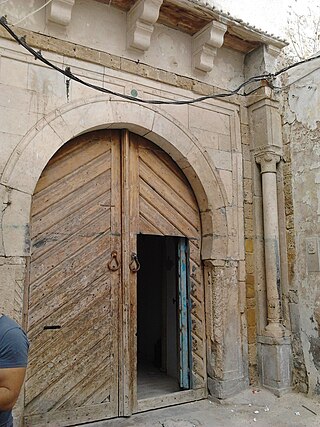
Dar Bach Hamba is an old palace in the medina of Tunis.

Dar Othman is one of the palaces of the medina of Tunis. The residence is located in the south of the medina, 16 El Mebazaâ Street.

Dar Lasram is one of the palaces of the medina of Tunis. It is located at 24 Tribunal Street.

Dar Hammuda Pasha is an old palace in the medina of Tunis. It is considered one of the oldest and biggest palaces of the medina that kept their original architecture.
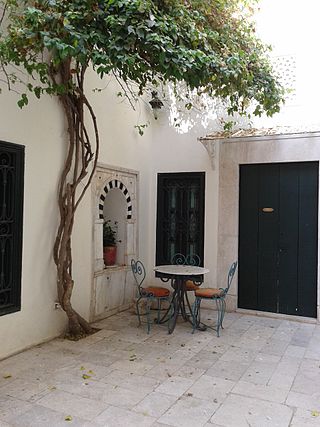
Dar Belhouane is a palace in the medina of Tunis, located at 64 Sidi Ben Arous Street. Today, it operates as a guest house.

Dar Caïd Nessim Samama is one of the palaces of the medina of Tunis.
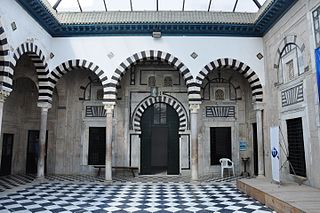
Dar Daouletli is an old palace in the medina of Tunis.
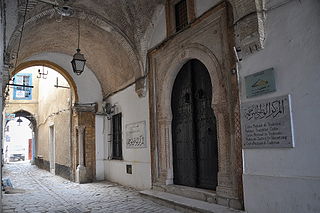
Dar El Monastiri is a palace in the Medina of Tunis.

Dar El Cherif is an old palace in the Medina of Tunis. It is located in Sidi Maaouia Street, near El Monastiri and Achour Streets.

Dar Batḥa, or Qasr al-Batḥa, is a former royal palace in the city of Fez, Morocco. The palace was commissioned by the Alaouite Sultan Hassan I in the late 19th century and finished under his successor Abdelaziz. It was converted into a museum of historical arts and crafts in 1915 with a collection that now comprises over 6,500 objects. The palace is located near Bab Bou Jeloud at the western edge of Fes el-Bali, the old medina quarter of the city, and close to Fes el-Jdid, the new medina quarter. It is adjacent to the Dar el-Beida palace located to its southeast, which was originally part of the same complex.

Dar el Bacha is a palace located in the old medina of Marrakesh, Morocco. It currently houses the Museum of Confluences.

Dar Glaoui or Glaoui Palace is a late 19th-century and early 20th-century palace in Fez, Morocco. It was owned by the Glaoui family, whose most famous members were the Grand Vizier Madani and his brother Thami, pasha of Marrakech. The palace is located in the southwestern district of Fes el-Bali, in an area containing other historic mansions.